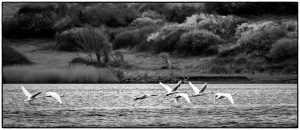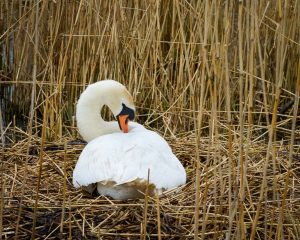Photo of the Day – 29 March 2017: Nesting Swan
There cannot be many jobs which have not changed over several centuries. One such is the position of swanherd at the Swannery in Abbotsbury, Dorset. It dates back at least to the 14th century, with the first written record in 1393. In practice, it most likely predates that. The swanherd was originally a member of the Benedictine Monastery of St Peter’s. It was established in the 11th century before the Norman conquest on land given by King Cnut. He, of course, is better known as the monarch who demonstrated that his regal powers did not extend to commanding the incoming tide on a beach.
Mute swans are usually very territorial and will aggressively defend an area of around half a mile in extent on a river or lake. However, conditions in the Fleet lagoon which is behind Chesil Beach are so good for rearing young, wild swans congregate there in unusual proximity. During the spring and summer, there are likely to be 500 or 600, many of which are nesting pairs. The monks took advantage of this phenomenon to rear birds for the table. Hence the presence of a swanherd to ensure that as many cygnets as possible survived during the breeding season. As a result, it is the largest managed colony of wild swans in the world.
Apparently, swans do not make for very good eating. The meat on the adult birds is too tough, so it was only the cygnets which the monks consumed. Even that has a fishy taste, but it suited the monks. During the Middle Ages, the days of the week on which meat could be consumed were proscribed by religious law. That left fish as the only other option. With an admirable logic, the monks decided that if something tasted of fish, that was good enough for them.
Nowadays, the Swannery is a tourist attraction. It has been a popular haunt for my wife and me. Over many years we have got to know some of those who work there. I used to take a lot of pictures when visiting, but more recently tend to be selective in what I shoot. They might be picturesque birds, but I know from experience that does not always make it easy to obtain a worthwhile image. Being large, it takes a lot of effort for swans to get airborne and they do not tend to fly much. If I can, I try to get shots of them in the air.

Swans flying across the Fleet
Of a burst of 8 shots, this was the only one where all the birds were separated.
(Click on the image for a larger version)
The current swanherd is Dave Wheeler. We bumped into him just as we were leaving and he was arriving. The Swannery was in the news earlier this year when there was an outbreak of bird flu. Dave told us that it kept him and his team occupied for around six weeks, searching the lagoon to find and remove the dead birds. Last summer had been a particularly good year for breeding, with around 200 cygnets surviving, twice as many as usual. Unfortunately, it was a particularly virulent strain of flu which mainly affected those which hatched last year. The younger birds really need exposure to a milder form to gain resistance. Some did survive, though, and overall numbers are consistent with previous years.
Another shot for which I had been hoping to get was of eggs by a swan’s feet. Laying had just commenced, but we were a little too early. Dave said there were a few eggs, but we did not see any. It does, of course, require the swans’ cooperation by standing up to reveal the eggs they are sitting on. Not this time, maybe on the next visit.
This post is part of my occasional “Photo of the Day” series. I publish shots which I think might be of interest and tell the story behind them. They might not necessarily be portfolio standard images, nor the final version, but still be of sufficient interest for inclusion in my blog. If I do not show a shot on any given day, it does not mean that I did not take any photographs, just that I did not get anything worthwhile. For me, that is part of the fun of photography. Not knowing what I will find on a shoot when I have nothing planned.
